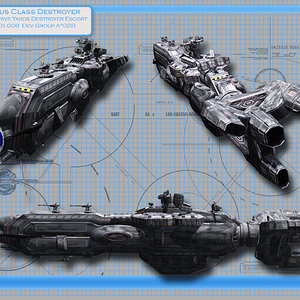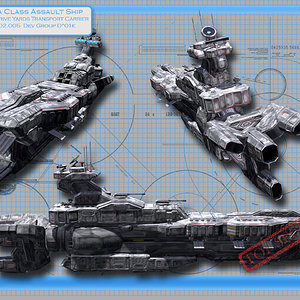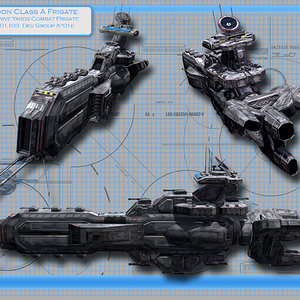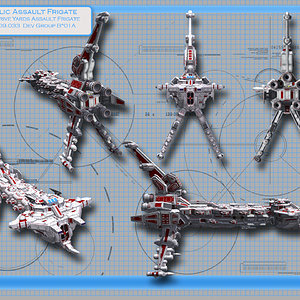ARMAMENT:
2 Turrets of Single 145 mm (Approx. 6 Inch) Stabilized Cannons
16(Approx.) Dual 55 mm Anti-Aircraft Turrets
Undisclosed Combat A.P.U.s
COMPLIMENT:
75 Officers, Crew, and Gunnery personnel operating in three shifts, plus 2 full platoons (50 men) of Colonial Marines as ships security. Troop Transport Capacity for 2 full Companies, including support staff and vehicles with some room to spare (about 300 men).
The Utah's interior is broken into 2 distinct sections - the Crew and Officer areas, and the Troop billets. The Crew and officer areas are what one might expect of a combat vessel - cramped, ugly, noisy, and very grey. The Crew are assigned two in a room, in bunked billets resembling a college dorm room. Each room has a single closet that must be shared, and enough space for each crew member to also have a single foot locker of personal items and belongings. Each room also has a single wash closet which is shared. The overall layout of the State rooms are like dormitory blocks, with a number of rooms in each block sharing public showers and a physical recreation room. A single large cafeteria on each deck serves all of the blocks on a given deck, and doubles as the recreation room or social room when not serving meals. The officers quarters are larger, with independent, private lavatories. There is also a separate Officers mess, recreation room, and small weight room. The billets of the on-board marines is much different, with the marines being housed in large group rooms more reminiscent of a cargo bay lined with double-decker bunks. Each such bay houses 10 men, with each man being allotted a single footlocker of space for personal effects. Each of these bays also has a group lavatory and shower, as well as a weight training space and lockers and equipment racks at the far ends. The marines weapons are stored in Weapons lockers in the bays, with the officers and Non-commissioned Officers having proper clearance codes to access for rapid deployment if necessary. The second section of the vessel, housing the troops being transported, is designed and layed out into several "Barracks" that are directly attached to nearby Armory and Launch Bays for rapid landing and deployment of forces. These "Barracks" are not much different from those used by onboard security marines, only larger, with each housing a full platoon of troops, and a total of six of these Gymnasium like rooms. Unlike the smaller rooms, movable privacy walls are used to open up or close off sections of each of these bays to allow some privacy between squads, or created areas for work and study for officers. These bays attach directly to group lavatory and showers for each bay, and from those the Armory and Gear Lockers, and then access locks to the launch bays. The Vessel also maintains a PX and Commissary on the primary cargo and munitions deck that is accessible to all crew. A Utah class Transport maintains numerous launch bays for troop landing craft, as well as a primary flight bay that services many launches, shuttles, and landing craft (Typically 2 shuttles and 4 to 6 launches/Landing craft) for the purposes of cargo and personnel loading and unloading. On average a Utah Transport also maintains a compliment of nearly 2 dozen Utility A.P.U.s for maintenance, repair, and cargo handling. Each Utah class transport maintains it's own compliment of around a dozen combat A.P.U.s for close support operations, defense, and boarding, in addition to any Combat A.P.U.s assigned to platoons in transit. When transporting Air-Cav A.P.U. platoons, a Utah may have up to 172 deployable combat A.P.U.s if needed - and it is not unheard of for Utah transports to be assigned such units for the purposes of closing with enemy vessels and boarding them.
HISTORY:
First entering service in the mid 2100s, at the height of the Binary Wars, the Utah was somewhat revolutionary in it's design for the time. Out of the necessity to construct numerous ships filling numerous roles, the Norfolk Drive Yards invested in massive, modular production lines and a level of collaboration between their design teams that was unheard of. As with many ships of this era to come out of the Norfolk Drive Yards and her sister yards, the Utah has visual similarities with other ships and classes. The Most notable feature of most of the small to Mid sized capital ships is it's use of the ubiquitous Herkimer reactor core and triple Worchester-V21 Engineering subsection. In fact this reactor and engineering sections was first designed for the Utah, and performed so well it became a mainstay of the new modular design theology of the Norfolk yards. For it's time the Utah also featured a fairly sophisticated Communications and sensory array that could overpower much interference and jamming at close range and insure easy and reliable coordination between other vessels in it's support group and it's deployed ground assets. The Utah was also fitted with a pair of stabilized cannons for defensive engagement and troop support, though this second use proved unattainable in space to planet engagements.
With the Majority of the fighting of the Binary Wars being on the ground, the need for adequate troop transports was paramount. Up until this point, the E.O.C., which had been very much relegated to a background governmental role not even considered an authority by Corporate colonial govenors, had been using refit colonial transports and cruise liners to move large volumes of troops. These vessels were poorly equipped for the logistics of such a task, and lacked any staying power or survivability in a combat engagement, and thousands of lives were lost to these factors. At the heart of design concerns for the Utah series transports was the ability to rapidly deploy a combat ready force and survive combat conditions. A large allotment of the vessels design and space was used for the maintenance and hanger facilities for drop ships and launches to deploy it's ground assets quickly. The primary launch and deployment bay was designed into a two-tiered hanger deck relying on a single large blast door and internal magnetic pressure barriers in the front of the vessel, which would typically only be opened when all flight capable transport launches were ready for a single mass deployment. This also proved to be a significant design flaw, as a well placed strike at the right time would not only criple the Utah's launch and recovery capabilities, but potentially wipe out 2 full companies of troops and support personnel. This failing was demonstrated in the battle for Westgate Colony when several Utah's suffered cripling hits of this nature delivered by the fast moving Freerunner Corvettes defending the colony. A second significant failing of the Utah was it's lackof strong defensive weaponry. While the Utah did feature 2 turrets of 145mm Stabilized cannons, these turrets were slow to track and slow to fire. Additionally, the Utah's anti-fighter defenses were thin and underpowered, being only 55mm, and mostly protecting the bridge and conning tower of the vessel. While these 55mm guns were more than sufficient against the upgunned civilian craft commonly used by raiders, scavengers, and piractes, they proved barely adequate against well armored combat fighters used by corporate militias. The Utah was not designed or intended to operate autonomously or even in groups of transports with proper defensive vessels and fighter support, and this became all to clear in it's early failures during the later half of the Binary Wars and during the corporate insurrections.
Countless Utah class transports and variants were constructed and sent into military and private service in the nearly 200 years since it's initial design. It has seen often modifications and tinkering for new roles or to adapt it to modernized technology. While it's production run has been ended, so many of these vessels exist it is still in wide service with no present plans to completely retire it. Variations exist for the Utah in wide array thanks to Norfolk Drive Yard's modular design theology of the era, ranging from up-gunned weapon platforms, to stripped down cargo carrier or triage vessels. While the Utah suffered many losses, and has definite failings in design, it has proven in combat that it can take a beating, and so remains favored by many. It has been in service for so long, with so many ships retired from damage or lost, it turns up frequently among mercenaries, private militias, and even pirates. It has been shown that against lightly armed civilian traffic, the Utah is more than a match in the hands of skilled pirates.
CREDITS: Davorama (a.k.a Davo, Beyondbent, Powerfusion3D, PoserFusion3D), All the great Kitbashers who have posted images of assemblies with Davo's sets that inspired me.








